Mike asked me recently if I had any interest in testing a new wadcutter loading that Georgia Arms Ammunition was producing. Mark Fricke, the Director of American Firearms Training and Tactics in Arizona, along with retired Georgia lawman (and now gun writer) Rob Garrett, had been working with Georgia Arms on the wadcutter and could provide a sample for us to review. I knew Mark from the NRA National Police Shooting Championships, seeing him every September, for several years, when Albuquerque hosted the NPSC. Mark did a fine job running the shotgun match and I always enjoyed visiting with him there. He had a box delivered to me in short order.
A special, Special
Examining the ammo showed that it was loaded in new Starline brass casings. The bullet looked like a standard target wadcutter (Fricke informs me they’re made by Zero Bullet Company) and was loaded flush with the top of the casing. The ammunition was clean and uniform and came packaged in a 20-round plastic tray in a cardboard box.
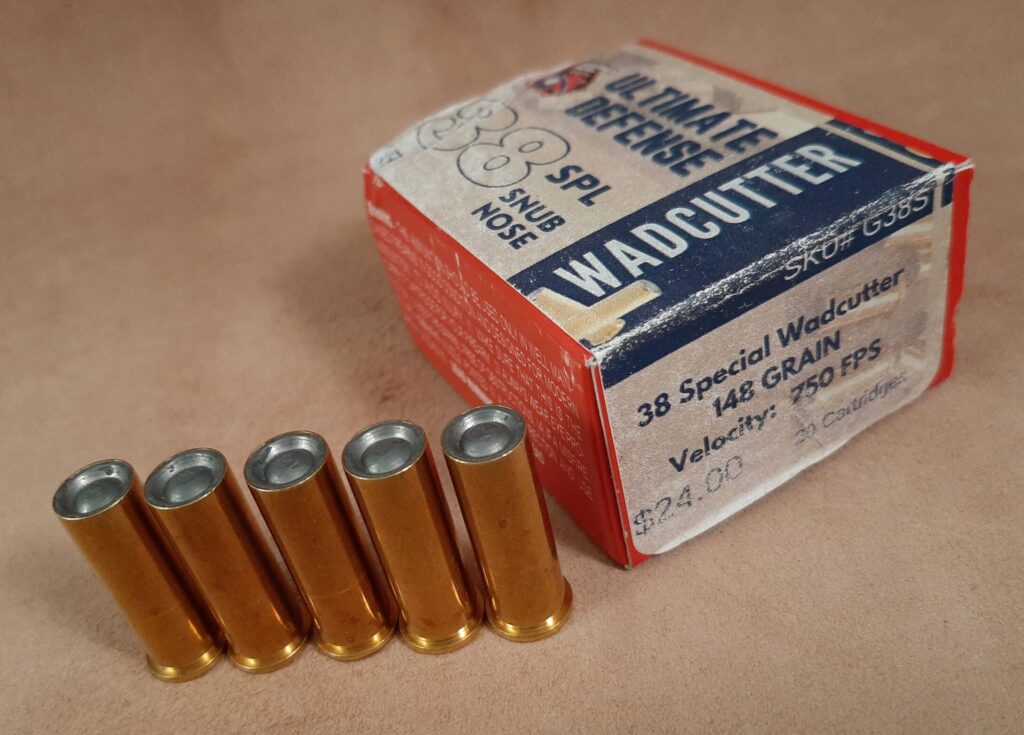
It’s designated the Ultimate Defense .38 Special SNUB Nose 148 grain Wadcutter, SKU# G38S. It was meant to provide maximum velocity and penetration from 1 7/8” barrels, while minimizing recoil in light weight revolvers. The box advertises the velocity at 750 fps. GA’s website lists that velocity from a 1 7/8” barrel, 825 fps from a 4” barrel. The ammunition retails at $24.00 for a 20-round box.
cold weather testing
I got a chance to shoot some on a chilly day in early December, the temperature was 35 degrees as I set up targets. I had brought match wadcutters from the “big three” manufacturers to compare to the GA stuff.

I ran a cylinder of each through my old Smith & Wesson 442 J- frame from 10 yards. This 442 isn’t known for producing maximum velocities, but it’s the only J-Frame I own with a 1 7/8” barrel. I was sitting on a camp stool and shooting unsupported to get down to the level of my chronograph on a short table. It was very overcast and windy to go with the cold. The sights on my 442 are OD green and getting a precise sight picture on a B8 target in that light was tricky.
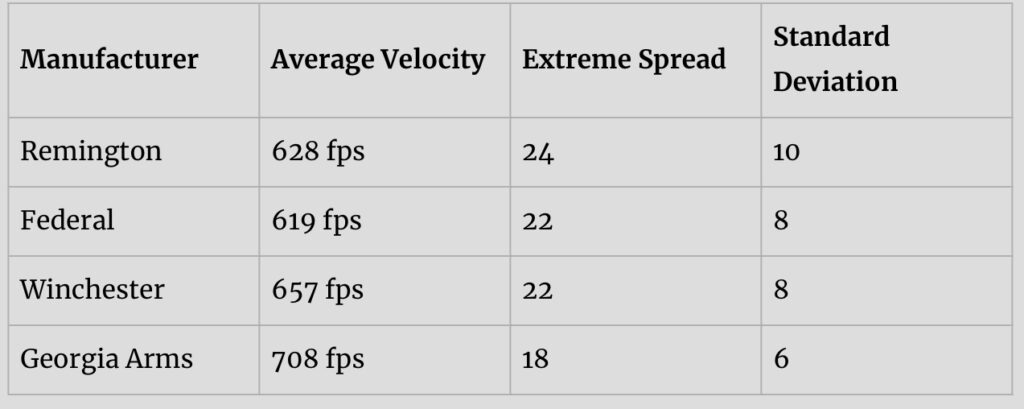
The velocity of the GA Snub Nose load is higher, as promised. Its noteworthy that it’s more consistent than all 3 match loads based on the ES and SD measurements. That’s a testament to the quality control of GA’s loading procedures! It also shot a slightly better group than the major players in my gun. I shot a cylinder’s worth of the Georgia and the Winchester ammo through a 2.125” barreled Smith & Wesson Model 640 as well. The Winchester Super Match went 661 fps through the longer barrel, The Georgia Arms hit 725 fps.
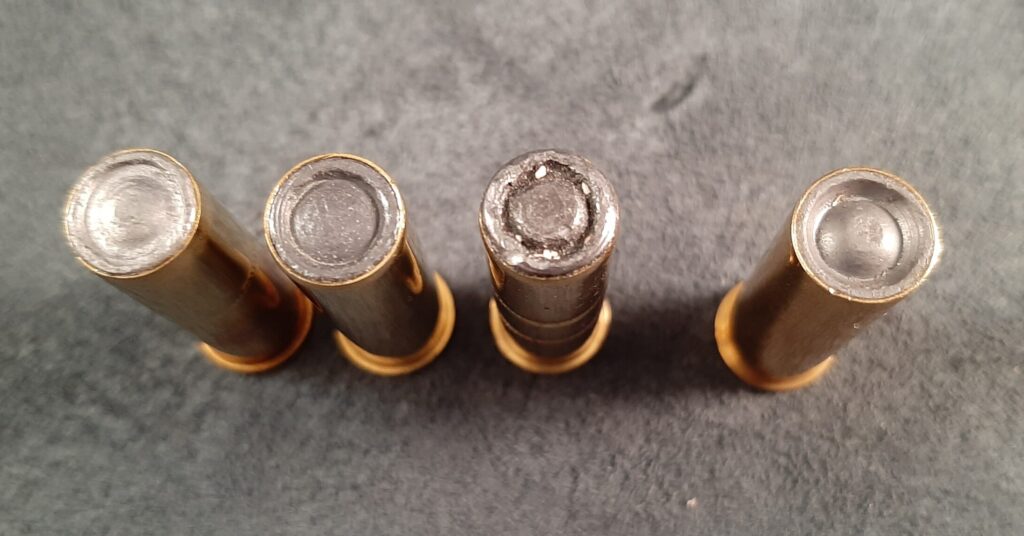
I have no way of testing Brinell Hardness of lead bullets, but the Zero Bullet Company bullet looks like it’s a bit harder than the alloys used in all three match bullets. That’s a good thing in a bullet meant for defensive use at these velocities to maximize penetration.
Accuracy testing
I loaded another cylinder in the 442 and fired five rounds from five yards as fast as I could get a decent sight picture. The rounds impacted in a tight cluster where I was aiming. I couldn’t feel any increase in recoil over the match loads; the GA load was pleasant to fire through the Airweight revolver. There was no obnoxious +P report or flash and recovery time was quick.
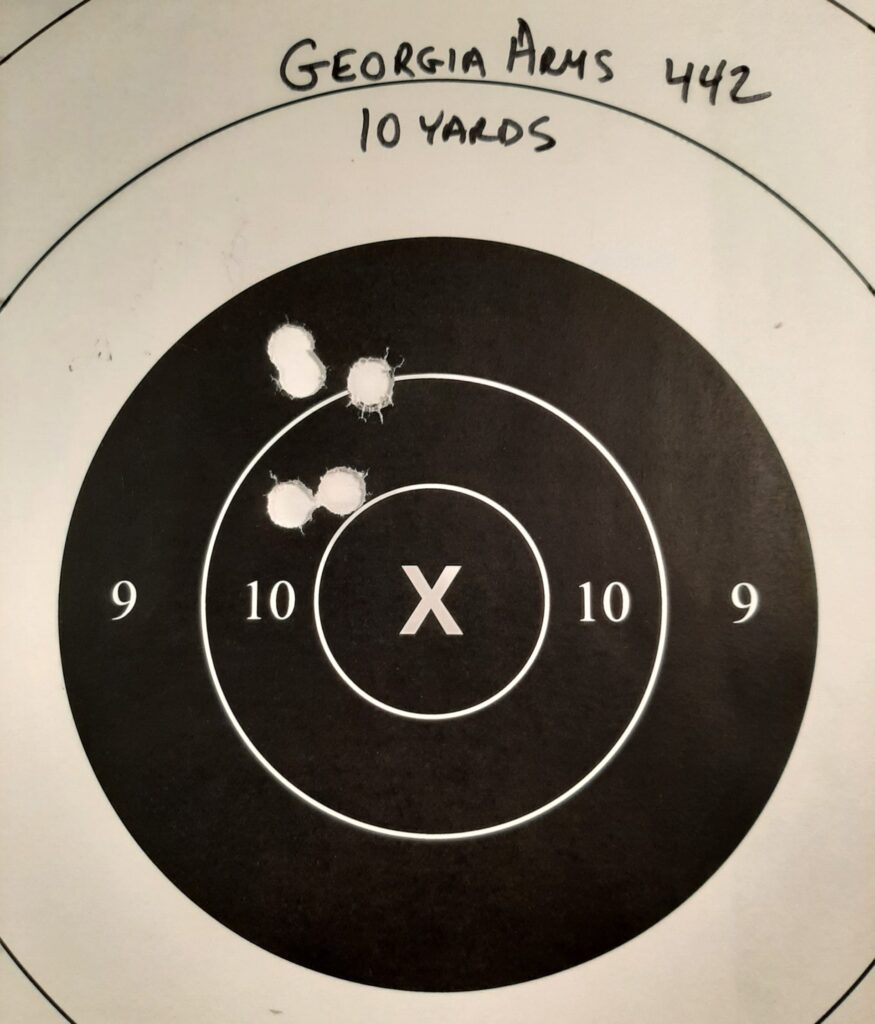
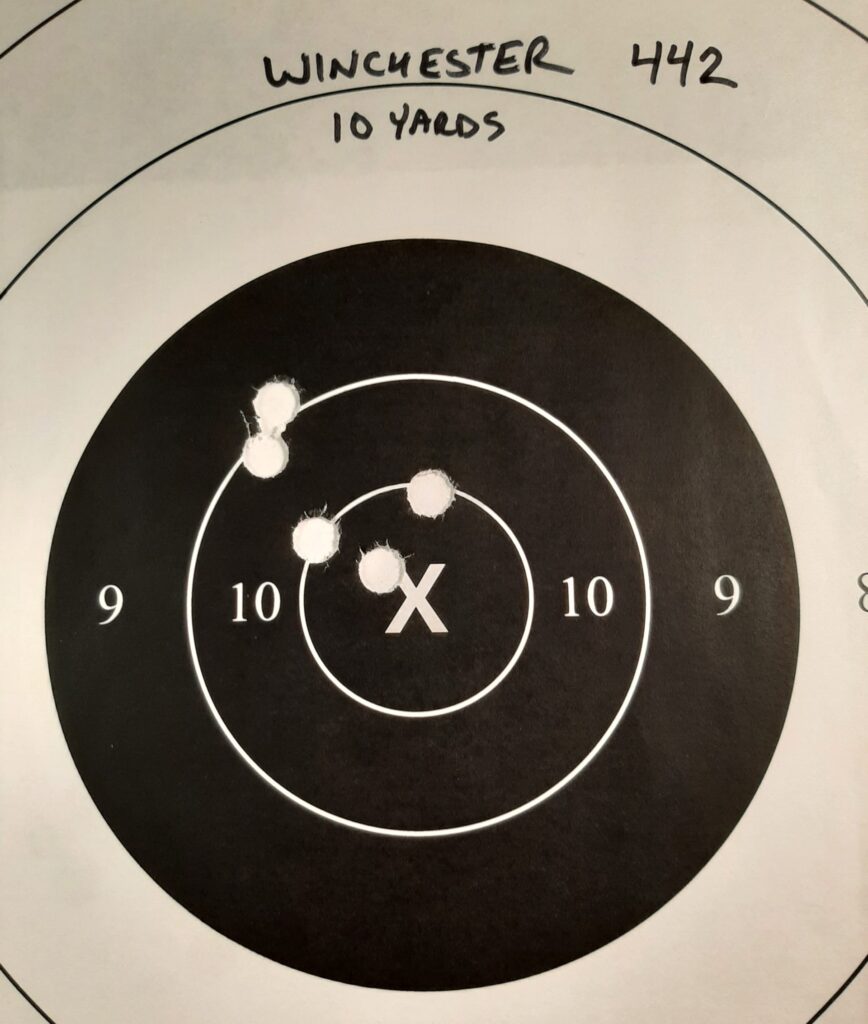
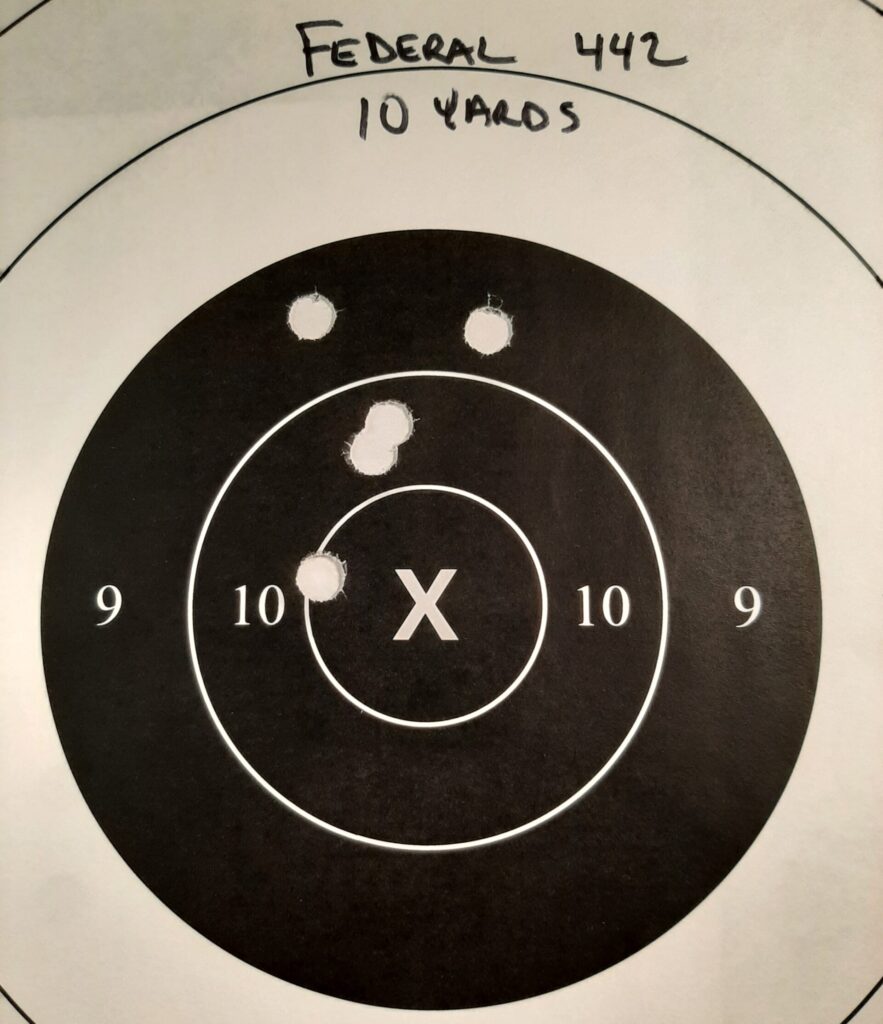
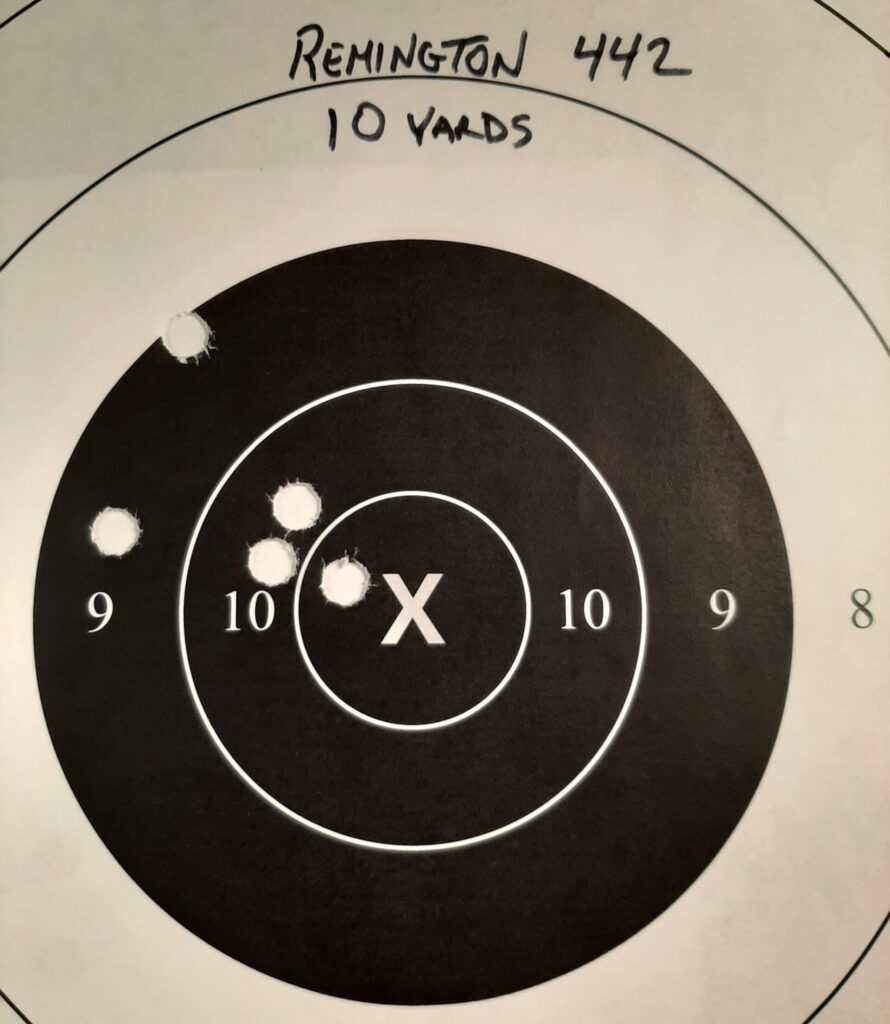
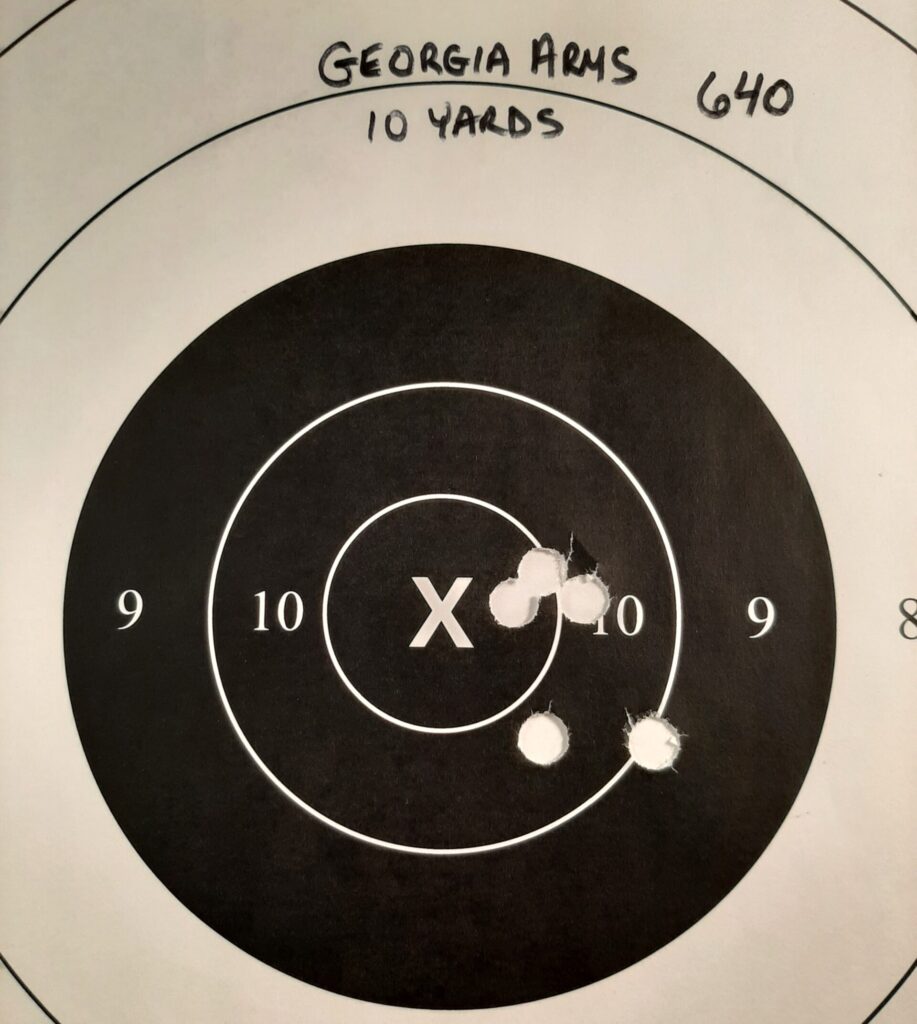
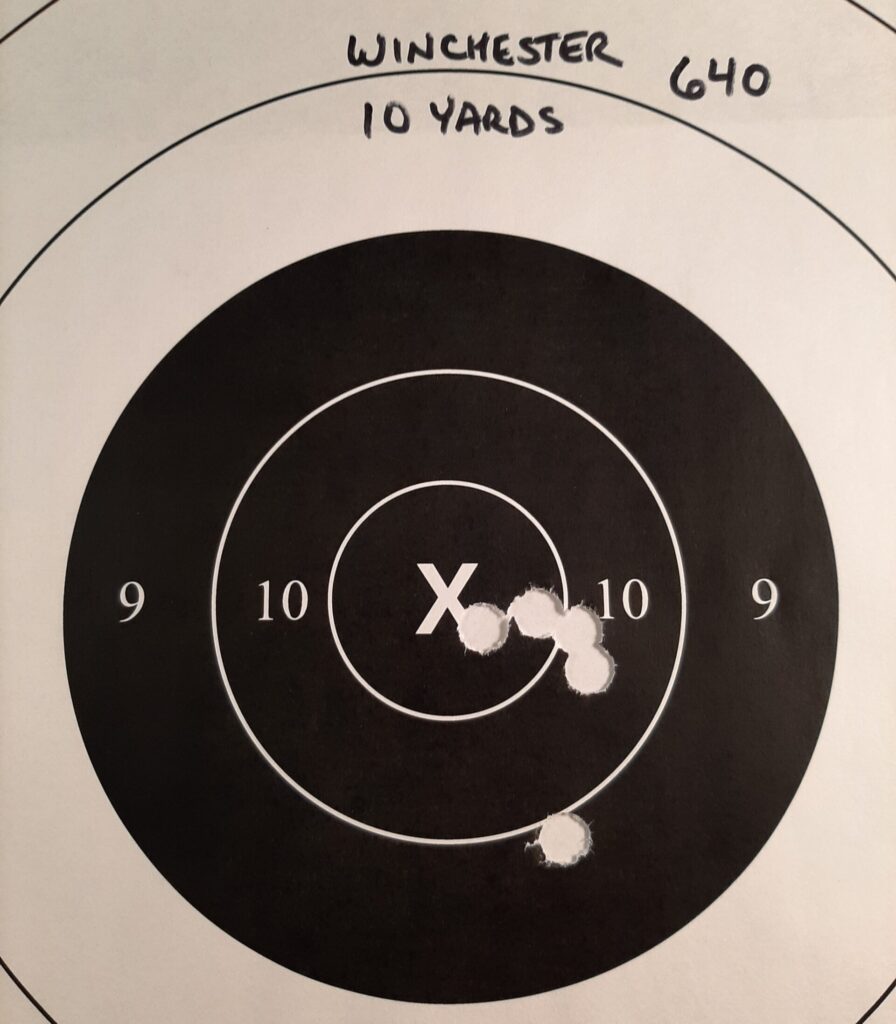
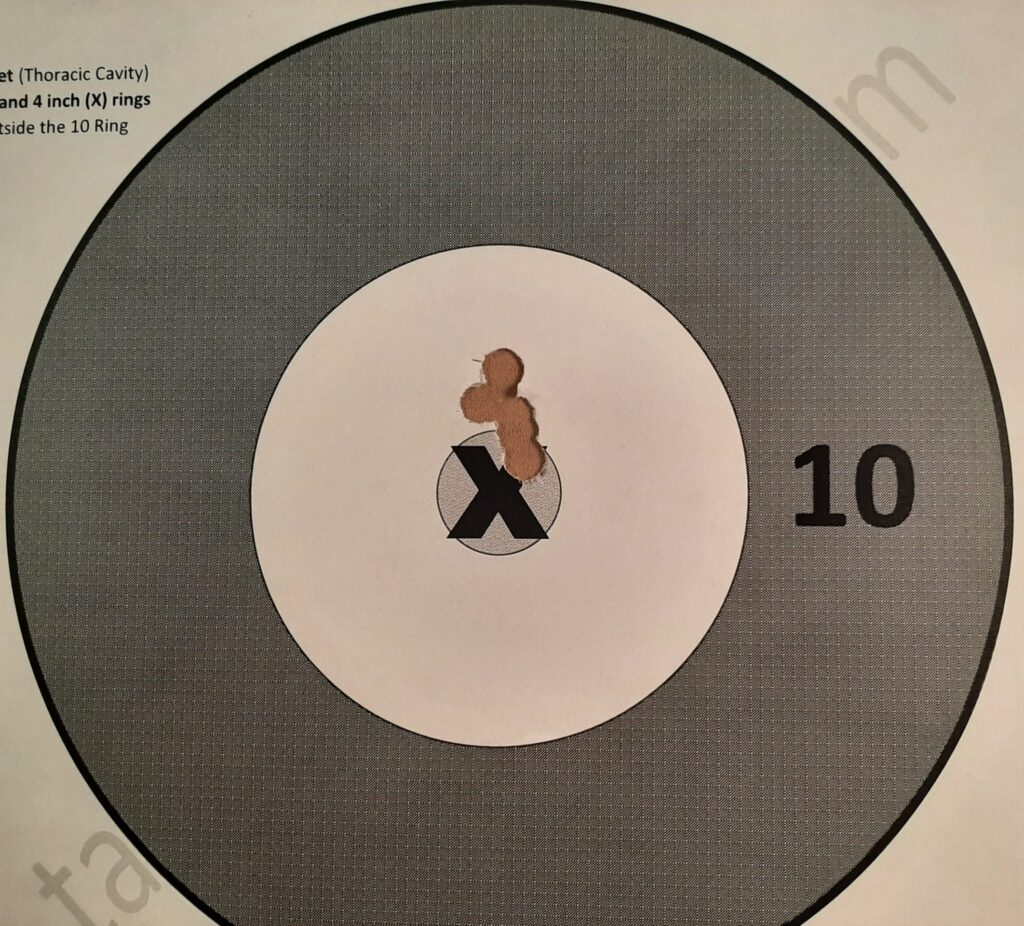
the sweet spot
I was very impressed with the concept and the execution of this ammo. There are a few other defensive wadcutters out there, but they’re listed at about 1000 fps muzzle velocity. No doubt they’ll be effective, but a gnarly handful in an alloy framed small revolver. The Georgia Arms Snub load perfectly addresses the need for a low recoil defensive load by using a wadcutter at the speed this one travels. It provides a noticeable increase (51-89 fps) in velocity over the big factories without a discernable bump in recoil.
Most jacketed holowpoints don’t achieve their advertised velocities in snub barrel lengths. It’s difficult to make JHP’s expand reliably at these diminished velocities. Wadcutters don’t rely on expansion for effectiveness; They cut a sharp full caliber hole and penetrate deeply. Cast bullets provide more velocity than jacketed ones of the same weight because they generate less friction. Consequently, they produce higher velocity for the same pressure. This might not be much of a factor in a .44 Magnum with a 6-inch barrel, but it’s huge in a .38 Snubby. Especially one that’s not rated for +P ammo.
practical, tactical
I recalled being on the range a month or so ago and a retired buddy of mine asked if I could give his wife a little refresher training with her gun. She was in her 70’s and had some injury/surgery issues with her hands. Her gun turned out to be an older Model 36 steel J frame. Unfortunately, the only ammunition they had for it was 125 gr. +P JHP stuff. We did lots of dry fire because I was afraid that our live fire would be brief with that ammo. When we did shoot, she managed 3 rounds before it became too painful to continue. I was wishing for a box of wadcutters so she could tolerate (and maybe even enjoy) more live fire. This GA load would be the perfect fighting ammo for her in that gun.
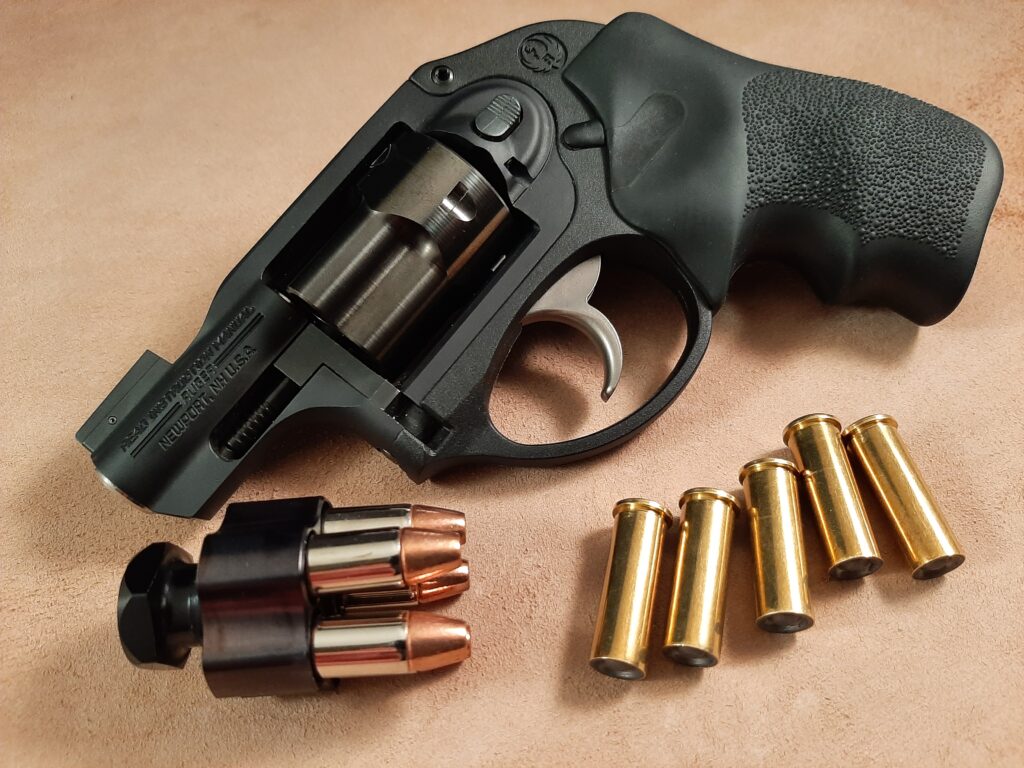
Like any wadcutter, these are a little tricky to load from a speedloader into a small revolver under adrenaline dump stress. It makes sense to load them in the gun and use a bullet with a more forgiving ogive in your loaders or strips in the event a reload is required. These are hard to beat for the 5 or 6 needed in your little carry revolver, though.
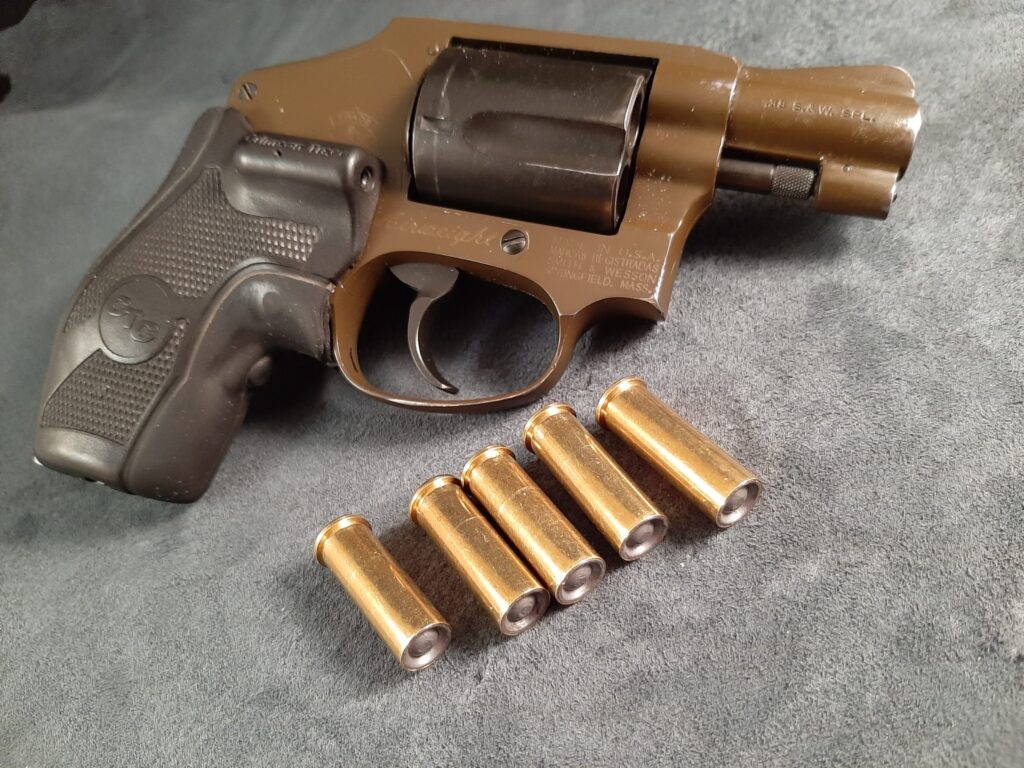
I had five left from testing, so I dumped the factory lead SWC’s from my 442 and loaded these Georgia Arms Wadcutters in it to carry. I can give this ammo no better praise than that. I will be buying more.

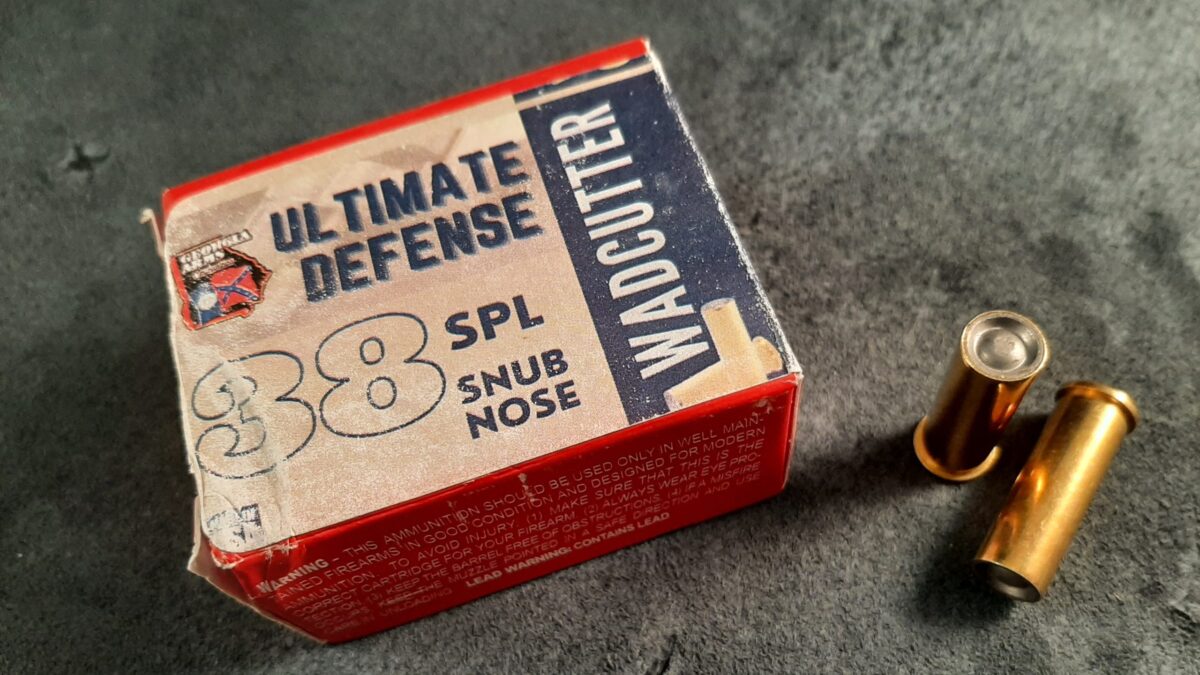
Very informative; this is why my .38 Smith J-frame alloy snubby only carries wadcutters. It makes no sense to me why some people stoke small, lightweight revolvers with hot +P and .357 Magnum ammo even if those pieces can safely handle them.
Georgia Arms wadcutters appear to be the best in the field.
Thank you, Spencer! These loads strike a really good balance in lightweight snub guns. Just because one can shoot .357 magnums in a 12-ounce titanium framed revolver doesn’t mean that one should… I heartily agree with you, Sir.
It’s great ammo- props to Georgia Arms for putting it out there.
Those edges certainly look sharp! I’ll be buying some for certain.
Hey Riley,
I don’t think you’ll be disappointed. The folks at Georgia Arms did their homework on these!
These rounds look like factory-new ammo. I only knew GA as a maker of reloaded ammo.
I’ll find a box. I like wadcutters and carry a snub (Hornady Personal Defense +p) which is fine in a Kimber K6S but maybe not in an airweight. But I want to see if a wadcutter might give me even better accuracy.
BTW, the 442 looks like serious business. I like that gun a lot!
Hey Ol+Wheelgunner,
You’re correct. All new components on these; factory new ammo.
I would give them a try, accuracy was outstanding in my little guns.
Thanks for appreciating my 442! I picked it up cheap in the late 90’s because it looked like its previous owner stored it in a saltwater aquarium! It made a trip to see Walter Birdsong shortly after Y2K and he was able to rehab it pretty well. He coated its guts too, and that slicked up the action nicely. That gun has been on my person more than any other in the last 25 years as a backup or a deep cover gun. It’ll do…
These are new ammo
Great review, Kevin! Now, if I can just find some…
Thank you, Kevin!
I hear you. I just went to G.A.’s website and they are out of stock. Hopefully they can rectify that shortly. Take care down there!
Kevin, thank you for that review. My backup is a S&W M37-2, and I’ve tried some of the so-called higher performance ammo. As you aptly point out, in small Airweight guns, they are not really in an ideal platform. Out of my 4″ S&W M27, hot .38s are enjoyable; out of my M37, not so much. These promise to be very controllable.
Until Federal came out with their 130 grain HST load for .38 Special, I carried regular the match target wadcutters from the ‘big three’. All were swaged bullets that always made me wonder what sort of performance I would see on the street.
This Georgia Arms round has real promise. The hard casting and very pronounced contour is substantially improved over some other hotter factory wadcutter defense loads. These should cut clean through clothing, and even jackets, and penetrate very well to vital areas.
It seems that what is old is once again new, and folks are re-discovering that the humble wadcutter is more than up for the job as a truly effective round for guns that by their nature are velocity handicapped.
As for Ol+Wheelgunner’s concern, I’ve been to the Georgia Arms plant and seen their operation. They kept me supplied in primers back in the day when I had to keep the Dillon up and running to keep up with the amount I was shooting. They are every bit state of the art as the ‘big three’. They have operations for reloading ammunition and separate operations for what we would call ‘factory loads’. Both operate to the same high standards of quality control. During my training class days, we got our range ammunition from Georgia Arms and never once had any issues.
Awesome testimony, thanks for that, Stuart! Very helpful!
Thanks, S. Bond.
It does seem that what is old is once again new. Wadcutters have always been a solid but underrated choice, and you’re right that this G.A. load takes it up a notch with the careful projectile selection they made. I have carried a wadcutter handload that runs faster than the big 3, but a factory offering removes that little buzz of worry that can park in your subconscious about carrying homemade ammo for social purposes. Thanks for the vote of confidence in Georgia Arms.
The biggest difference is these are loaded to give adequate penetration out of a 1 7/8” J frame barrel. Standard PPC wadcutters are loaded for accuracy, not penetration.
Rob
How’s the recoil on these compared to HST micro 130gr. Those were some very light recoiling load.
They’re light, Michael. The whole point was to make them manageable in a snub. I shot some in an aluminum 642 recently and recoil was very reasonable to me. Lighter than the 130 grain +P loads I’m used to.
I’m glad to hear good things about them. Might get reloading supplies from them in the future. Too bad they don’t have any .38 Spl brass or bullets at the moment.
Members of a facebook snub group got a heads up about this round a few months ago and we waited, somewhat impatiently, for it to come out. A recent podcast in which Mr. Fricke participated talks in-depth about the GA wadcutter’s development. We finally have a round specifically manufactured for our snubs! Thanks for the comprehensive review and comparison to my usual carry round, the Winchester Super-X.
You’re welcome, Mr. Shailer. It’s pretty cool that this loading was built from the ground up for snub carry purposes. Match wadcutters work well, these are even better. I guess I need to come out from under the rock once in a while- I had no idea these were in the making until Mike brought them to my attention!
Another great article. I retired my 38 Special 158 grain SWCHP +P loads and started carrying wadcutters in my 642 after reading Mark Fricke’s report on gel tests conducted at the 2021 Pat Rogers Memorial Revolver Roundup. The 2022 PRMRR test results are out now as well and data continue to demonstrate the many values of the wadcutter in small revolvers. My former carry load in my 4-inch GP100, the Winchester 110 JHP 357 Magnum, penetrated only 9.2 inches of bare gel and just 12-7/8 inches after four layers of denim. Compare that to the Georgia Arms Ultimate Defense Wadcutter 38 Special, which penetrated 15.75 and 14.5 inches in the same media, fired from a Ruger LCR! I was able to buy a box of the Ultimate Defense Wadcutter load at the 2022 PRMRR. Performs as promised; pleasant to shoot and hits to the sights at practical distances (7 and 15 yards). As a bonus, I can create 148 grain practice ammo on the Dillon quite easily using age old recipes. Mark Fricke and Rob Garrett are the guests in Episode 96 of The Off Duty On Duty podcast. It’s an informative listen. BTW, The 2023 PRMRR is scheduled for November 18-20 at Gunsite Academy. Don’t know if there are any spaces left (I’ve got mine) but there’s no one who follows this blog who wouldn’t find it wonderfully entertaining.
PS I also carry round nose FMJ (130 grain Federal) for my reload. It also offers modest recoil and shoots to the sights. Figure if I need to recharge during an emergency I figure a good bullet now is better than the best bullet later. Cheers!
Thank you, Mr. Brady. Mark and Chuck Haggard do us right with their gel tests (and data dissemination of same) at the Pat Rogers Memorial Revolver Round Up. Thanks for highlighting the PRMRR, too. It has swiftly become the preeminent event for our “tribe”and I hope to attend one soon. You make a good point about using practice ammo that acts like your fighting ammo. Wadcutters make that simple, whether you use factory wadcutters or handloads for your practice ammo. Not all carry loads are as easy to duplicate with respect to point of impact and similar recoil impulses as wadcutters. That Federal 130 FMJ is probably the easiest projectile of all to find a chargehole with in a hurry. I can’t fault your logic with “a good bullet” now theory!
Kevin, great article. Enjoyed it very much. What you and S. Bond said was exactly what was running through my mind about nothing new under the sun.
Matters more how well you use the sights than what you have in the chamber.
Thanks Tony! There’s nothing wrong with old and proven; we just tend to repackage and recycle it alot! A lot of wisdom in your statement about those sights…
Nice review. Thank you.
Rob Garrett
Gentlemen
I just spoke to Curtis and the snub load is in stock. However, there has been a run so if you need some, you better hurry.
Rob
Kevin
I just spoke with Curtis and he wanted me to pass on his appreciation for this great article.
If your readers would like to hear more details on how this load came about and it’s performance, check out Episode 96 of the Off Duty On Duty Podcast, that Mark and I did with Bryan Eastridge.
Warm regards,
Rob
Another great feature of using wad cutters is that they hit point of aim. Those light weight +P rounds all shoot high but I find the wad cutter shoot tru to the sights.
Thanks Jack, it’s an excellent point. I find the high speed lightweights shoot significantly low, but the 148 grain wadcutters always hit at the right elevation.
Exactly, Mr. Connolly. Most fixed sight .38’s have traditionally been zeroed for 158 grain cast bullets at velocities garnered from standard pressure loads. Wadcutters hit to roughly the same point in all the guns I can recall shooting that were regulated thusly. That is no small point in a fixed sight gun!
Hey Rob! Thank you very much for the kind words. Thank you also for the work you and Mark did with Georgia Arms to bring this concept to fruition, and please tell Curtis he’s welcome too!
I appreciate the heads up on the Snub Load being available right now and I know our readers will, too.
I will check out the podcast-keep up the good work, Sir! Thanks again.
Personally, my favorite carry load is Steinel Ammo’s 125gr +P snub load. I find it has consistent accuracy and surprisingly manageable recoil in both my S&W 642 and Taurus 856, as well as larger revolvers like my S&W Model 10.
I have switched to my 856 for daily carry because it is all steel and easier to shoot, among other factors. However, a lightweight snub like my 642 still has a place, and I’d be open to trying these wadcutters by Georgia Arms should I ever come across some.
Hey Axel, I got some trigger time with an all steel 856 3″ today, I concur it’s easier to shoot than an airweight snub and makes a great choice for an edc gun (more on that soon). I think you’re right that it’s the perfect gun for a 125 gr. +P load, too. The GA wadcutters sure shine in an alloy gun with a short barrel like your 642. Give em a try when you get the chance!
Why did Georgia Arms not seat the Wadcutters out past the mouth of the case. This would build case volume which would allow for more velocity at equal pressure. Since quick reloads with any full wadcutters are out of the question, a longer length wouldn’t cause any issues. 800+ fps would penetrate deeper than 700+ fps. When penetration is all you have, the more the better.
Brett, I don’t know for sure, but will guess that loading them flush protects the (relatively) soft bullet better, and it allowed them to obtain the desired target velocity. Faster would give more penetration, but also more recoil, and a big design goal was to minimize recoil in small Airweights. I think that velocity hit the sweet spot for the balance of recoil and penetration.
If you listen to the podcast referred to above, they played with several velocities. They only wanted the fbi penetration (bare and 4 layer denim) from the sub 2 inch snub barrel at the lowest recoil was how I understood it. Not trying to crack a bear skull or a car door.
Jason
Nice to have another option. I will try some of these out myself. I have carried wadcutters for decades in my steel and alloy snubs. I typically have been carrying Buffalo Bore or Underwood 150 grain hardcast wadcutters or lately Precision One 148 grain copper jacketed wadcutters which are another very consistent ammo as well. I have tried everything under the sun from SJWC’s to Gold dot short barrel and I believe wadcutters to remain the better choice for 2″ guns as a consistently performing self-defense round with maximum control.
Hey CD, thanks for weighing in. I agree Buffalo Bore and Underwood are great offerings, if a bit spicy in really light guns. I wasn’t familiar with Precision One’s offering- I’m curious if they get decent velocity with a jacketed wadcutter. Thanks for mentioning them! Wadcutters do seem to hit that sweet spot you described in 2″ guns with regards to performance and control.
BITD when old guys would suggest wadcutters for social work, most of us ‘smarter’ younger guys would poo-poo the idea; because after all, the lead was too soft and the velocities from target loads just didn’t have enough oomph (that’s a technical term) to get deep enough to do the job. The idea of a ‘cookie cutter’ effect sounded good, though. Then again, none of us was smart enough to think of a harder-cast bullet and an extra 100fps velocity. I’m in the column who will be giving these a try; maybe it will replace the current BUG load.
Regarding having trouble seeing the front sight, I had the same problem with dark or dull sights even when the eyes were much younger. In the ‘old is new’ section, there is a cure that’s less expensive than installing new sights. There are several brands of Sight Enhancement Compound available, in dozens of different colors, which are simple to apply and cost very little. Some people call this stuff Fingernail Polish. I’ve used it for decades to good effect. Just pick the color that your eyes see the brightest, dab it on the sights, and you’re ready. An under layer of white first will usually brighten the color. Also, a bit more expensive but usually brighter and more visibler, is glow-in-the-dark craft paint; a quick hit with a flashlight, and the sights are even easier to see in dim light. Just an idea that works, doesn’t cost much, and can tend to start some interesting conversations with the tacticool guys at the range. Ace
Ace, those old guys knew some stuff, huh? Guess what? You’re now one of them!
Ummm, Excuse me Colonel, ain’t that a case of “the pot calling the kettle, black?” And before anybody goes there…I AM DEFINITELY OLD, soooo.
Great article, Kevin. Once again, what was old, is new again! There’s bound to be an old J-frame around here somewhere, begging for this G.A. stuph!!
Haha! Guilty, as charged, DB!
Thanks, DB! You’re right, this is the perfect load for old J frames that might no longer get carried to avoid beating them up with modern +P JHP’s. Let’s pull them out of the safe and put em to work!
Amen to old guys knowing stuff, Ace! We would never have to invent anything new and cool if we would just listen to those guys- they have probably already tried it! I have found that when I have a really great idea, I run it by my buddy Dwayne Worley. He was a sixgun toting lawman prior to my birth, and 9 times out of 10, he already did it! I am to the point that my Sight Enhancement Compound needs batteries, so I am approaching old guy status too!
Great article, and also great shooting!
It makes a lot of sense to use these if your ammo won’t hit the velocity that hollow points need to expand, which reminds me of a question I’ve wanted to ask here for a very long time but keep forgetting.
As you pointed out, most snubbies don’t have enough barrel length to reach the velocities advertised, but what is the sweet spot as far as barrel length for 357 magnum or 38 special? I’ve heard people say you don’t lose a significant amount of velocity using a 3” barreled revolver instead of a 4”, but I have no idea if that’s true. I definitely understand it’s kind of a generality since different powders have different burn rates and bullet weight is another variable. I love my 686-3 with it’s big original wood grips, but for carrying a 3” gun would be a lot more practical I’d think.
Keep up the great work, I really appreciate the work your entire staff puts in to this!
Ian, I’m not Kevin, but I did stay at a Holiday Inn last night . . .
As you noted, there’s a whole lot of variables at play, and it’s a little dicey to make blanket statements. I’ve seen some significant velocity differences between guns of the same make and model as a result of chamber and bore dimensions, and barrel-cylinder gap. Oftentimes, these factors can change velocity as much as a change in barrel length does. Then there’s a whole new set of factors when we talk about ammo—powders, primers, bullets, crimp style, and so on.
It’s also important to understand that certain barrel length changes become more critical, based in large part on the burn rates and pressure curves of a given powder. What I mean by that is, the changes in velocity are not uniform—sometimes cutting an inch off a barrel gives you “X”, and sometimes cutting the next inch gives you much more than “X,” because you’re looking at a different point in the combustion timeline.
Referring to the excellent work done by the guys at Ballistics By The Inch, for example, cutting back from 4” to 3” resulted in an average velocity loss of 219.250 fps across a range of eight different .357 Mag loads (from a low of 177 fps for the Corbon 110 gr. to a high of 259 fps for the Federal 130 gr. Hydra Shok Low Recoil), but cutting back from 3” to 2” resulted in an even greater average loss of 256.125 fps for the same eight loads (from a low of 181 fps for the Corbon 110 gr. to a high of 353 fps for the Corbon 125 gr.). Put another way, the penalty of cutting back from 3” to 2” was more severe than cutting back from 4” to 3” for the eight .357 Mag loads they tested. That’s a pretty standard phenomenon, which is why the snubs take a hit in performance, and the 3” guns are becoming more popular, as alternatives.
Regarding ease of carry, sometimes lopping off barrel length actually makes it harder to carry a gun. It sounds funny at first, but it’s true. A gun with a longer barrel can often stabilize better in IWB or OWB carry, and not tip away from the body as much. It can be more comfortable and concealable than a similar gun with a shorter tube, in the right holster-belt combo. Obviously, things change when the carry mode shifts to pockets, ankles, etc., where the shorter barrels shine.
I’ve always found the Medium-Large frame of the 686 was a little too much of a good thing for any kind of concealed carry, and the snub versions don’t carry well at all. Instead of looking at a 3” 686, I’d be much more prone to look at a K-frame, myself. The K’s just carry better, in my personal opinion. That’s one of the reasons I think Ruger is suffering from not having a true Medium frame gun in the catalog, in between the GP and SP series. The GP is too much gun for lots of us to carry concealed, and the SP lacks a 6-shot cylinder. We need a Mama Bear option from them.
Hi Mike,
You may not be Kevin but I can honestly say I respect and weigh your opinion as highly as any other revolver guy out there today including Mas Ayoob (if Elmer Keith has a ghost somewhere you’d be just a little under him though! Hahaha).
That was some really eye opening information, thank you very much for sharing it. I used to conceal a 2 1/2” GP100 Talo edition easily appendix IWB, I really regretted it not being 3” like I was told but I also REALLY regret getting rid of it. Also I think you’re right about my 686, I don’t think there’s a very practical way to conceal that. I’ll have to keep my eyes open for a model 65, old six series gun, or just maybe one of the newer offerings from Colt if I research them more.
As a machinist I can’t help but wonder if I could improve velocity by changing bolt gap, but I digress. Anyways, thanks again Mike!
Thank you Sir! Very kind of you. I’ll take second or third place to Elmer any day!
You can certainly change the velocity with a tighter B-C gap, but will negatively affect reliability. About 4-6 Thou is probably the sweet spot for most revolvers.
The new Colt King Cobra is worth a hard look, and Justin has done some strong writeups of it in these pages. Slightly smaller than a K-Frame, but six shots and good sights. A 3” barrel is standard. An attractive package for carry, that will pack much easier than a 686.
Thank you, Ian! Mike did a great job answering that question. I would add that with a .38 Special, most rounds I have chronographed show a noteworthy velocity improvement going from a 2″ to a 3″ barrel. Not scientific, but enough to make the 3″ really appealing as a primary carry if you choose a .38.
For that “Mama Bear” concealed carry option, I hereby request that Ruger resurrect their Security-Six revolvers, with three-inch barrels. Other configurations would be appreciated, too!
Amen, brother!
I hope Ruger is listening, Spencer. A Speed Six 3″ with slightly better sights and a sweat resistant black finish would sure be nice…
Ive been saying for years how do you load jacketed bullets made to work at magnum speed in a slow 38. Always said but never did anything about it
Hey Steve,
You’re right- it’s nigh on impossible to get jacketed bullets designed to expand at magnum velocities to perform well from 2″ .38’s. Modern bonded bullets like Speer’s Gold Dot Hollow Point have generous velocity performance windows, but it’s tricky to get there in short barrels. This Georgia Arms loading gives reliable penetration at the speed snub guns can reasonably muster. They may not mushroom like a hollowpoint in a gel test, but they stand a great chance of consistently reaching vitals.
This was a fortuitous find! I’ve recently gotten into hand loading at the same time I’m transitioning from autos to wheel guns, and plan to practice with my 442 and M60 a lot using home brew SWC rounds. I find it amazing they can charge only $24 for “defensive ammo.” Amazing.
Thanks for the recommendation!
By the way, not sure if you know this, but the 640 was James Can’s weapon of choice in Way of the Gun.
I missed that one, Taylor. I’ll have to look it up. Glad you enjoyed the article—a snub loaded with WCs is a great option.
Hey Taylor, Glad to help! GA does sell them at a fair price.
For high volume practice loads, I might suggest that you look at loading coated round nose flat points (RNFP’s). The rounded ogive makes reloading from speedloaders or strips a little easier than SWC’s and the polymer coating makes em slippery and cleaner shooting. They still have a flat meplat like a SWC, so they’re terminally superior to a round nose. Glad you are transitioning away from those pesky electric guns, you won’t regret it!
Mr. McPherson
Great article. I’ve been a fan of Zero bullets for a long time. I occasionally shoot Bullseye (now called precision pistol) and I’ve been buying their bullets for several years now for that purpose.
I beleive I recall something about Lee Juras and Supervel experimenting with a load such as this and then I went on to read about some of the late Jim Cirillos “developments” in order to make his Model 10 38 Special more effective (as if he needed to). With this in mind and being a reloader myself, I loaded some rounds using 148g hollow base wadcutters from Hornady, turned upside down with a gas check on, what is now, the rear end. It works and is accurate for its intended purpose. My own model 442 will group these loads into a similar cluster as your does at 5 yards. I didn’t go crazy frettin over velocity, just a healthy dose of Unique for a HV load.
Thank you, Mr. Carr. The fact that you use their bullets for Bullseye is a great endorsement for Zero bullets. I got a chuckle out of your “as if he needed to” comment about Jim Cirillo- ain’t that the truth! I have also heard of lots of folks experimenting with hollowbase wadcutters loaded upside down, using the hollow base as a gaping hollowpoint. I don’t recall anyone using a gas check, but that’s a great idea on a swaged wadcutter to keep it from seriously leading the bore at high velocity. I bet those expand quite dramatically with a healthy dose of Unique! I suspect they generate a bit more recoil than the GA load! Thanks for writing in, Sir.
Wadcutters in first. Hornady ftx in speed loaders. But I have all Rugers so i dont fit right in.
Hey Steve,
I find no fault in your choice of armament, what resides in the cylinder, or what occupies the speedloader. It ought to work!
As a charter member of the old cop club, I had my j frame stoked with wad cutters. Besides if I ever needed to use it, it would have made it easier to score the “target”. Relax… just kidding! Will bolo for these rounds for my LCR. Great info, thanks.
Put em all in the K5 zone, Alan! 😁
You’re welcome, Alan! Old cop wisdom is hard to beat. Thanks for your insight.
Enjoyed the article – thanks. Availability seems to be an issue so I’m surprised that no one has mentioned the DoubleTap Hard Cast 148 Grain Full Wadcutter as an alternative. They are reported to do about 730fps from a 1 7/8” LCR; I would think this is comparable to the GA offering. My experience with them has been positive.
Norm, my understanding is Georgia Arms suffered a fire and production was (is?) interrupted. The DoubleTap WC is only slightly slower, and would certainly be a worthy replacement. It’s a great recommendation, thanks!